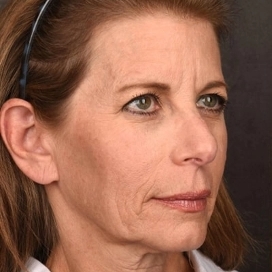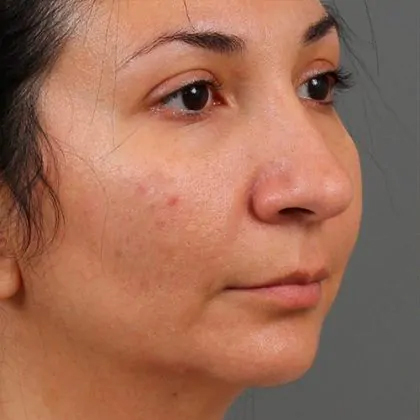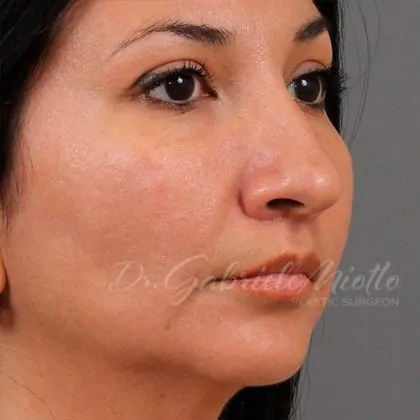Fat Grafting to the Face
Conveniently located to serve the areas of Atlanta, GA

Fat grafting (or fat transfer) to the face is a cosmetic procedure that transfers fat from one area of the body to the face to increase facial volume and decrease signs of aging.
A loss of facial volume can lead to wrinkles or smile lines that you would rather do without. If this is the case for you, there are treatment options available to help you achieve a more youthful appearance.
It is important that if you are seeking facial rejuvenation treatment, you go to someone you can trust. Dr. Gabriele Miotto and the ME Plastic Surgery team are the best Atlanta has to offer when it comes to cosmetic surgery, offering a variety of facial rejuvenation procedures and constantly staying up to date with the latest in new, effective, and innovative treatment methods.
If you are looking to restore facial volume, fat grafting to the face could be right for you.
To schedule a consultation, fill out our contact form or call (404) 850-5851.
Contents
About Fat Grafting (Fat Transfer) to the Face
Fat grafting is a surgical approach to facial rejuvenation. Fat grafting is your natural filler. When it comes to facial rejuvenation, unlike traditional methods such as dermal fillers, fat grafting offers a biological approach to facial rejuvenation by taking your fat tissue from one area of the body and transferring it to the face. By using one’s own adipose tissue (fat) to restore volume to the face, there is a decreased likelihood of an allergic reaction because an individual’s body fat is more biocompatible than artificial fillers. (1) Also, we are replacing “like with like”, and restoring the facial fat that has been lost. The procedure is performed either under local or general anesthesia.
Fat transfer procedures are designed to help patients restore volume and reverse the signs of aging without making it apparent that a patient has undergone a significant cosmetic procedure. The goal is to create a rejuvenated look while still maintaining natural features.
Benefits
The benefits of fat grafting procedures are numerous and can extend well beyond just helping someone restore volume in their face, as these procedures, especially when performed by an expert such as Dr. Miotto, can help reduce the signs of aging on the face. Some of the benefits associated with fat grafting procedures and the results associated may include, but are not limited to, the following:
- A more natural approach to restoring volume
- Minimized wrinkles
- Improved proportions of the cheeks, temples, eyelids, and lips
- Less risk of an allergic reaction due to using one’s own adipose tissue as opposed to artificial fillers
- Improved skin quality
- Increased facial symmetry (2)
As you can see, fat grafting produces many physical benefits for patients. Fat grafting has been shown to create striking improvements in skin quality which produces a more youthful, rejuvenated look. (3) Beyond these benefits, restoring a youthful appearance can also provide a boost in confidence.
To learn more about the many benefits of fat grafting procedures or other procedures offered by Dr. Miotto, schedule a personal consultation by calling (404) 850-5851.
Ideal Candidates
Facial fat grafting can appeal to a wide variety of candidates, most of whom are individuals who have experienced facial volume loss and are looking to restore fullness. This procedure appeals to people who prefer a safer, more natural alternative to traditional facial filler procedures as well as people who might be allergic to the formulas used in traditional filler procedures.
Candidates should be in overall good health but still possess enough body fat to make a proper fat transfer possible. Ideally, patients are non-smokers or people who are willing to quit the usage of nicotine or alcohol before the operation. Additionally, individuals should have realistic expectations about what they can accomplish with fat grafting procedures.
Personal Consultation
The first step toward facial rejuvenation is scheduling a personal consultation with Dr. Miotto. During this meeting, Dr. Miotto will sit down with each patient and go over their medical history, overall health, and aesthetic goals. Once Dr. Miotto has enough information about the patient, she will get to work on creating a personalized treatment plan that will include details about the preparation, procedure, and recovery process and might include recommendations for additional procedures as well. The consultation also serves as a way for patients to ask any questions or address any concerns they might have going into the procedure.
To schedule a personal consultation, contact Dr. Miotto and the ME Plastic Surgery team by calling (404) 850-5851.
Preparation
Fat grafting is a surgical procedure which means the preparation process is extremely important for a successful procedure. Dr. Miotto and her staff will provide a list of step-by-step instructions to help guide you through this process. Patients might be asked to undergo certain medical evaluations to ensure they are healthy enough for this surgery.
In general, it is recommended that patients stop using nicotine or alcohol several weeks before the procedure, as these can alter proper blood flow and potentially inhibit the surgery and healing process. The usage of blood thinners or NSAIDs should be stopped in the days leading up to the procedure. Additionally, Dr. Miotto might advise you to refrain from using certain medications that she feels could impact the procedure, which will be outlined in your personalized treatment plan.
The procedure will likely involve the usage of anesthesia, so patients should make plans for a ride home following the procedure accordingly. While the preparation process is important, Dr. Miotto and her staff will walk you through every step to make it a seamless experience.
Procedure

The procedure process will look different for every individual, but in general, a fat grafting procedure begins with the administration of either local or general anesthesia. Once the patient is determined to be comfortable, an incision is made and fat is harvested from areas known to carry more body fat such as the thighs or abdomen. The adipose tissue is then purified and reinjected into the desired areas of the face. Dr. Miotto carefully sculpts the face throughout the surgery process to create a natural, contoured look. Fat grafting procedures generally take a few hours depending on the procedure as well as whether or not any additional procedures are performed.
Recovery
After the procedure, patients will likely experience some swelling, bruising, and redness in the treated areas. These side effects should subside significantly after the first week. Many patients can expect to return to normal activities within a week, but patients should avoid strenuous activity for a couple of weeks following their procedure, or until Dr. Miotto approves. Our team will help you schedule necessary follow-up appointments so that Dr. Miotto can not only monitor your progress but also help guide you through recovery.
If you have any questions during your recovery, please do not hesitate to reach out to our office so that we can provide you with the information you need.
Results
While patients can expect to see some results immediately, it takes 3 months on average for the results to be final. Improvements in volume can be noticed as soon as the procedure concludes. Dr. Miotto and her staff are the best Atlanta has to offer, and they are confident you’ll be satisfied with the results of your fat grafting procedure. After your procedure, you will notice a rejuvenated, more youthful appearance that looks natural.
Cost of Facial Grafting Procedures in Atlanta
The cost of facial fat grafting will depend on several factors. An overall price estimate will be given during your consultation, and any questions you have about the cost of the procedure can be answered there as well. Dr. Miotto and ME Plastic Surgery offers financing options to those who qualify.
FAQ
The fat can be harvested from various areas, commonly the abdomen or thighs, where excess fat is present.
Fat grafting results vary per individual but often last several years after the initial procedures.
Yes! Many patients choose to combine facial fat grafting with other cosmetic treatments for comprehensive facial rejuvenation.
While generally safe, potential risks include uneven results, fat absorption by the body, partial correction, infection, and prolonged swelling. Your surgeon will discuss the risks of the procedure with you during your consultation. To hear from the plethora of patients who have achieved results with the treatments offered by Dr. Miotto and the team at ME Plastic Surgery, visit our reviews page. To stay up to date with Dr. Miotto and the expanding world of aesthetics, check out our blog.
References
- Brucato D, Ülgür II, Alberti A, Weinzierl A, Harder Y. Complications Associated with Facial Autologous Fat Grafting for Aesthetic Purposes: A Systematic Review of the Literature. Plastic & Reconstructive Surgery Global Open. 2024;12(1):e5538-e5538. doi:https://doi.org/10.1097/gox.0000000000005538
- Barone M, De Bernardis R, Persichetti P. Permanent Facial Fillers: Addressing Complications and Advancing Solutions. Aesthetic plastic surgery. Published online August 2024:10.1007/s00266-02404104-z. doi:https://doi.org/10.1007/s00266-024-04104-z
- Tonnard P, Verpaele A, Carvas M. Fat Grafting for Facial Rejuvenation with Nanofat Grafts. Clinics in Plastic Surgery. 2020;47(1):53-62. doi:https://doi.org/10.1016/j.cps.2019.08.006







